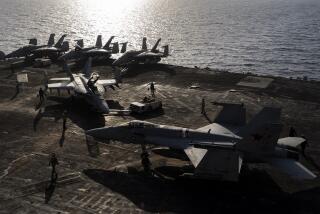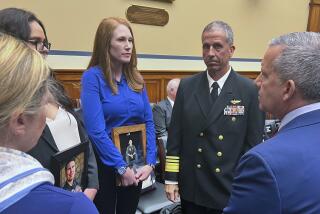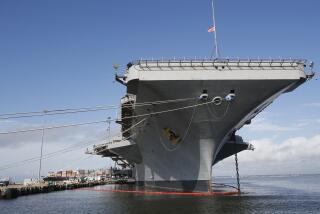Carrier Relies on Vigilance Rather Than New Security Procedures : Few Changes in Navy Supply Setup
ABOARD THE USS DWIGHT D. EISENHOWER — Here, 170 miles off Cape Hatteras, N. C., the nuclear-powered aircraft carrier Eisenhower is on a routine deployment, and Navy Reserve pilots on a refresher cruise are slamming aging F-4 fighters and A-6 bombers onto its floating 4 1/2-acre flight deck.
But, down below in room 2-119-1, Cmdr. Beryl Moore is ignoring the shudders that the planes send reverberating through the ship. He is thinking about a lot of little things, like eggs--500 dozen of them each day, to be exact--and expensive things, like inertial measuring units--worth $170,000 each and small enough to fit into a sailor’s footlocker.
Moore is the supply officer of the Eisenhower--the man charged with making sure, at sea and in port, that each can of soda pop, each pair of aviator sunglasses and everything else from arresting cables to zenar diodes gets to its proper destination and not into someone’s private stockpile.
Sensitive Job
That has become a particularly sensitive job since recent disclosures that operatives for the government of Iran spirited away fighter jet navigation systems and other equipment from somewhere within the Navy’s gigantic worldwide supply system and that someone aboard the Kitty Hawk, another aircraft carrier, ordered and made off with silver ingots for which there was no known use aboard the ship.
Problems throughout the Navy supply system will be the focus of a hearing Tuesday by the House Armed Services sea power subcommittee, which is expected to receive a massive report prepared by the Navy’s judge advocate general’s office on allegations of supply irregularities and diversion of sophisticated parts.
The report details “systemic problems” in Navy supply operations, according to a source who has read the 2,000-page document. “These are serious problems and a cause for concern,” the source said.
Despite the failures disclosed by the Navy’s internal investigation, however, not much had changed on board the Eisenhower as of its last deployment earlier this month. Although the Navy is asserting its intention to crack down on fraud, theft and abuse in its supply system, officers said that no new orders or procedures have been instituted aboard the Eisenhower.
Increased Vigilance
Rather, officers and crew members using 25-year-old computer programs--and more often using old-fashioned paper and signed receipts--are said by the captain to be employing increased vigilance to keep track of the 100,000 items the ship’s storerooms carry at sea.
“We’re doing with men what the modern world is doing with machines,” said Capt. Richard C. Macke, the Eisenhower’s commander, who is about to preside over the 8-year-old ship’s first thorough overhaul, in which--among other things--an up-to-date computer supply record-keeping system will be introduced.
There have been “no changes, other than going and taking a look” at supply operations in response to the Navy’s recently publicized supply problems, Macke said. “We’re running a good ship. I don’t see any problems.”
The supply operation, although one of the less glamorous aspects of running a nuclear carrier, is an integral element in keeping its 90 or so fighters and attack aircraft flying. The imperative that the Navy always be combat-ready means that parts and equipment must be available promptly--with few questions asked.
The Eisenhower’s 600-member supply team--approximately 10% of the crew--handles 5,000 parts requests every month. “I’ve got 75 guys who don’t do anything but work storage,” Moore said.
Storerooms--58 in all--are spaced throughout the ship, and requests for parts can be filled within an hour. A faulty electronics unit aboard an F-14 on the flight deck can be replaced with a spare kept in a miniature supply room on a deck-level catwalk.
“When you have that kind of responsiveness and you have what I’ll call a system that requires integrity, you can see where there would be some vulnerability,” said one Navy officer who asked not to be named.
“We’ve got these parts. We don’t lock them up like candy bars,” he said. “We know there are 6,000 kids on this ship that would like to get a candy bar from us if they had the opportunity, but we have not assumed that the average sailor would want an F-14 constant speed drive.”
Record Readiness Rating
Adm. James D. Watkins, chief of naval operations, remarked recently that, at the same time that problems were being publicized on the Kitty Hawk, the ship had a record-high readiness rating, “with not one person or aircraft lost after completing 8,500 landings and launches.”
“This sure doesn’t sound to me like the performance of a crippled ship or a floating horror story of scandal and crime, nor should responsible Americans allow her to be so libeled,” he said.
Moore said that the ready availability of the supplies and the number of spare parts kept on hand are responsible for the Eisenhower’s maintaining, on average, 85% of its aircraft at a rating of “fully mission capable”--ready to fly in combat at a moment’s notice.
Capt. Ed Straw, deputy comptroller for financial management in the Naval Supply Systems Command, acknowledged in an interview in Washington that “based on the environment we’re perceiving today, we need to tighten up security on board our ships.” He added: “We have already tightened up security significantly.”
High-Security Treatment
He said that items known to be of interest to Iran, other Third World nations or the Soviet Union--even if the parts are not classified--will receive the high-security treatment given classified equipment.
Of about 100,000 items in Moore’s inventory aboard the Eisenhower, no more than about 6,000 are considered expensive--radio transmitters, for example, worth $180,000. But these 6,000 account for 91% of the dollar value of the stocked parts.
These are given priority treatment as the supply office tries to improve security.
“Our first goal was to get our arms around the crown jewels,” Moore said.
Times Staff Writer Gaylord Shaw contributed to this story from Washington.
More to Read
Sign up for Essential California
The most important California stories and recommendations in your inbox every morning.
You may occasionally receive promotional content from the Los Angeles Times.










